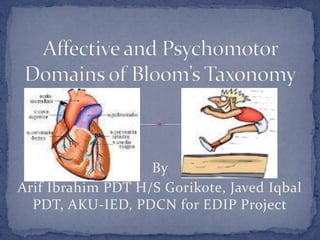
Psychomotor and affective domain of blooms' taxonomy
- 1. By Arif Ibrahim PDT H/S Gorikote, Javed Iqbal PDT, AKU-IED, PDCN for EDIP Project
- 2. Session Learning Outcomes Affective Domain Levels of Affective Domains Chart of Affective Domain Psychomotor Domain Levels of Psychomotor Domains Chart of Psychomotor Domain
- 3. By the end of this session C.Ps could be able; Discuss the psychomotor and affective domain of Bloom’s taxonomy, Differentiate between psychomotor and affective domain, Replicate the action words of psychomotor and affective domains sublevel whilst developing SLOs in their lesson plans
- 4. The affective domain (Krathwohl, Bloom, Masia, 1973) includes the manner in which we deal with things emotionally, such as feelings, values, appreciation, enthusiasms, motivations, and attitudes. The five major categories are listed from the simplest behavior to the most complex: Krathwohl, D. R., Bloom, B. S., & Masia, B. B. (1973). Taxonomy of Educational Objectives, the Classification of Educational Goals. Handbook II: Affective Domain. New York: David McKay Co., Inc.
- 5. Receiving. The student passively attends to particular phenomena or stimuli [classroom activities, textbook, music, etc. The teacher's concern is that the student's attention is focused. Intended outcomes include the pupil's awareness that a thing exists. Sample objectives: listens attentively, shows sensitivity to social problems. Behavioral terms: asks, chooses, identifies, locates, points to, sits erect, etc. 2. Responding. The student actively participates. The pupil not only attends to the stimulus but reacts in some way. Objectives: completes homework, obeys rules, participates in class discussion, shows interest in subject, enjoys helping others, etc. Terms: answers, assists, complies, discusses, helps, performs, practices
- 6. 3.Valuing. The worth a student attaches to a particular object, phenomenon, or behavior. Ranges from acceptance to commitment (e.g., assumes responsibility for the functioning of a group). Attitudes and appreciation. Objectives: demonstrates belief in democratic processes, appreciates the role of science in daily life, shows concern for others' welfare, demonstrates a problem-solving approach, etc. Terms: differentiates, explains, initiates, justifies, proposes, shares, etc
- 7. 4. Organization. Bringing together different values, resolving conflicts among them, and starting to build an internally consistent value system- -comparing, relating and synthesizing values and developing a philosophy of life. Objectives: recognizes the need for balance between freedom and responsibility in a democracy, understands the role of systematic planning in solving problems, accepts responsibility for own behavior, etc. Terms: Arranges, combines, compares, generalizes, integrates, modifies, organizes, synthesizes, etc. 5. Characterization by a Value or Value Complex. At this level, the person has held a value system that has controlled his behavior for a sufficiently long time that a characteristic "life style" has been developed. Behavior is pervasive, consistent and predictable. Objectives are concerned with personal, social, and emotional adjustment: displays self reliance in working independently, cooperates in group activities, maintains good health habits, etc. Prepared by Dr. J.J.Applied Sciences Education Research Group, FSG, UiTM, Shah Alam Web:http://www2.uitm.edu.my/drjj/
- 9. Level Description Verbs Objective Receiving Being aware of, or attending to Listen Listen attentively to something in the environment. Notice badminton Tolerate introduction. Responding Showing some new behavior as a Comply Voluntarily help set up result of experience. Enjoy badminton nets. Follow Valuing Showing some definite Carry out Attend optional involvement or commitment. Express badminton match. Organization Integrating a new value into one's Choose Purchase own general set of values relative to Consider badminton racket. other priorities. Prefer Characterization Acting consistently with the new Act on Join intramurals to value; person is known by the Depict play badminton twice value. Exemplify per week.
- 10. The Psychomotor Domain was ostensibly established to address skills development relating to manual tasks and physical movement, however it also concerns and covers modern day business and social skills such as communications and operation IT equipment, for example telephone and keyboard skills, or public speaking. http://www.businessballs.com/bloomstaxonomyoflearning domains.htm
- 12. Dave's (1975): Imitation — Observing and patterning behavior after someone else. Performance may be of low quality. Example: Copying a work of art. Manipulation — Being able to perform certain actions by following instructions and practicing. Example: Creating work on one's own, after taking lessons, or reading about it. Precision — Refining, becoming more exact. Few errors are apparent. Example: Working and reworking something, so it will be “just right.” Articulation — Coordinating a series of actions, achieving harmony and internal consistency. Example: Respond effectively to unexpected experiences. Revise treatment plant to adapt to changes in patient’s condition. Naturalization — Having high level performance become natural, without needing to think much about it. Examples: Construct a new theory. Create a new treatment approach.
- 13. Level Description Verbs Example Imitation copy action of another; copy, follow, replicate, watch teacher or trainer observe and replicate repeat, adhere and repeat action, process or activity Manipulation reproduce activity from re-create, build, carry out task from instruction or memory perform, execute, written or verbal implement instruction Precision execute skill reliably, demonstrate, complete, perform an activity with independent of help show, perfect, calibrate, expertise and to high control, quality without assistance or instruction; able to demonstrate an activity to other learners Articulation adapt and integrate construct, solve, relate and combine expertise to satisfy a non- combine, coordinate, associated activities to standard objective integrate, adapt, develop methods to meet develop, formulate, varying, novel modify, master requirements Neutralization automated, unconscious define aim, approach design, specify, manage, mastery of activity and and strategy for use of invent, project-manage
- 15. Thank You
